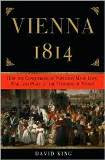 This post inaugurates a new series highlighting recent books of interest for anyone, who, like me, devours accounts of Napoleon and the Napoleonic Age.
This post inaugurates a new series highlighting recent books of interest for anyone, who, like me, devours accounts of Napoleon and the Napoleonic Age. In Book Three of War and Peace, Pierre Bezuhov stumbles
In Book Three of War and Peace, Pierre Bezuhov stumblesonto the Raevsky Redoubt and witnesses the Battle of Borodino; Tolstoy paints an unforgettable portrait, but how accurate is it really? Read Alex Mikaberidze's first-rate The Battle of Borodino: Napoleon Against Kutuzov, (Pen and Sword's Campaign Chronicles) and find out. Mikaberidze's colleague at the Shreveport campus of Louisiana State University, Michael V. Leggiere, also has an outstanding new book, the first in a two-part study that examines Napoleon's brilliant campaign of the spring of 1814, and, at the same time, unravels the complicated series of events and forces that led to Napoleon's fall. Leggiere's The Fall of Napoleon: Volume 1, The Allied Invasion of France, 1813-1814 (Cambridge University Press) will be continued in The War in France, 1814. And don't miss the extraordinary excitement that followed shortly afterwards, when the victorious powers (and a horde of others) poured into Vienna to redraw the maps, divide the spoils, and celebrate, which will be told in Vienna 1814: How the Conquerors of Napoleon Made Love, War, and Peace at the Congress of Vienna. Of course I'm not exactly unbiased, given my obsession with the dazzling, though little-understood Congress of Vienna, and well, you know.

 In the not too distant future, too, I look forward to reading my friend Jeremy Popkin's forthcoming history of the revolution on the French half of the island of Santo Domingo (Haiti), which had important repercussions not only for France, but also the young republic of the United States. I'm also very excited about General Michel Franceschi and Ben Weider's Wars Against Napoleon: Debunking the Myth of the Napoleonic Wars, which was just published by Savas Beatie in December 2007. Read J. David Markham's excellent review here.
In the not too distant future, too, I look forward to reading my friend Jeremy Popkin's forthcoming history of the revolution on the French half of the island of Santo Domingo (Haiti), which had important repercussions not only for France, but also the young republic of the United States. I'm also very excited about General Michel Franceschi and Ben Weider's Wars Against Napoleon: Debunking the Myth of the Napoleonic Wars, which was just published by Savas Beatie in December 2007. Read J. David Markham's excellent review here.
